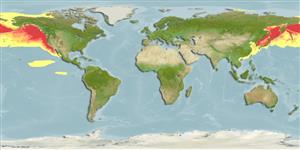Common names from other countries
Classification / Names / Names
Nomi Comuni | Sinonimi | Catalog of Fishes (gen., sp.) | ITIS | CoL | WoRMS
Environment: milieu / climate zone / depth range / distribution range
Ecologia
Batidemersale. Subtropical; 90°N - 0°S, 180°W - 180°E
Pacific Ocean and the Arctic.
Length at first maturity / Size / Peso / Age
Maturity: Lm ? range ? - ? cm Max length : 210 cm TL maschio/sesso non determinato; (Ref. 1394); 150 cm TL (female); Peso massimo pubblicato: 270.0 kg (Ref. 1394); Peso massimo pubblicato: 270.0 kg
Feeds on many varieties of epipelagic and vertically migrating schooling and non-schooling fish and squid; feeding is at night (Ref. 1394). Feeds on many varieties of epipelagic and vertically migrating schooling and non-schooling fish and squid; feeding is at night (Ref. 1394).
Life cycle and mating behavior
Maturità | Riproduzione | Deposizione | Uova | Fecundity | Larve
Estrus and copulation occur about a week after parturition. Implantation is expected 120 days after copulation.
Jefferson, T.A., S. Leatherwood and M.A. Webber. 1993. (Ref. 1394)
IUCN Red List Status (Ref. 130435)
CITES status (Ref. 108899)
Not Evaluated
Not Evaluated
Human uses
Pesca: commerciale
FAO - pesca: landings, species profile | FishSource | Sea Around Us
Strumenti
Fonti Internet
Estimates based on models
Preferred temperature
(Ref.
115969): 0.2 - 3.8, mean 1.6 (based on 2446 cells).
Resilienza
Medio, tempo minimo di raddoppiamento della popolazione 1.4 - 4.4 anni (K=0.03-0.38).
Vulnerability
Moderate to high vulnerability (51 of 100).
Price category
Unknown.
